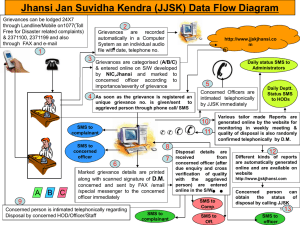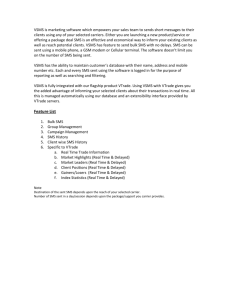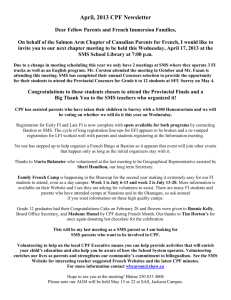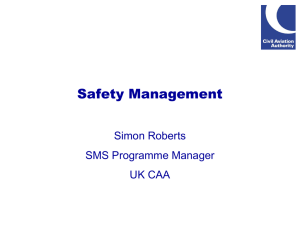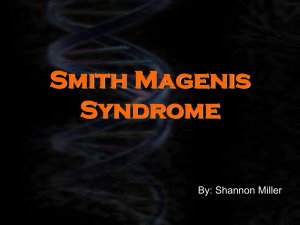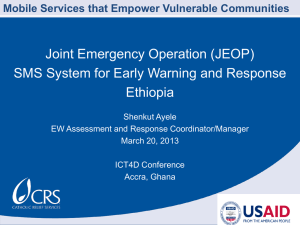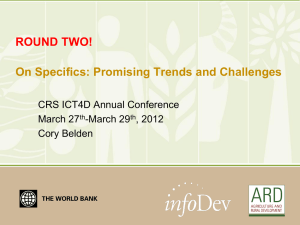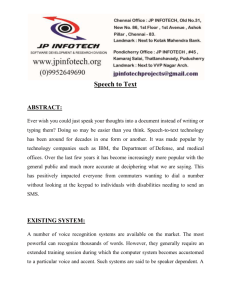Symptom Magnification Syndrome (SMS)
advertisement
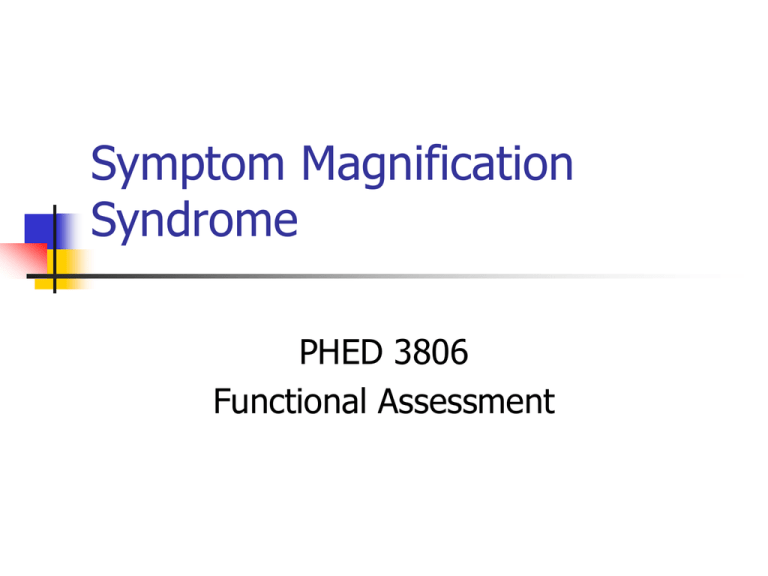
Symptom Magnification Syndrome PHED 3806 Functional Assessment Symptom Magnification Syndrome (SMS) History Identification of SMS Types Treatment HISTORY (brief) L.N. Matheson combined some existing key concepts to form a model that is clear and useful in viewing injured workers eg. from cognitive/social learning theories, chronic pain theories, social support systems. Talcott Parsons-sick role (escape other responsibilities) David Mechanic-illness behaviour (part of a coping repertoire which makes a challenging situation more manageable) Pilowsky-Abnormal Illness Behaviour-physical complaints but no organic cause IDENTIFICATION The individual appears to not be "responsible" for their symptoms and relates to him/herself as the “victim.” This is a vicious cycle in that he/she feels the environment is uncontrollable but in essence the symptoms he/she exhibits ends up controlling the environment. IDENTIFICATION The symptoms are non-negotiable. Vagueness and/or lack of awareness may indicate the person is not taking responsibility for developing activities to control the symptoms, or cannot answer “what makes it worse” since he/she has been avoiding engaging in activities to find out. For SMS, symptoms can't be made worse or better . . . “nothing makes it better.” Self-descriptive statements such as "the pain won't let me . . ." IDENTIFICATION It is a self-destructive pattern of behaviour learned and maintained through social reinforcement. IDENTIFICATION SMS is composed of reports and/or displays of symptoms and the symptoms magnify his/her functional limitations. Look for . . . less than a full effort, over-reaction to loading, work themes that are not based on recent experiences or not consistent with recent experiences eg. I have problems with my back when doing . . . (perhaps his/her back has not been an issue for 7 years!) IDENTIFICATION SMS may be conscious or unconscious . . . the person may not even know that they are exhibiting certain patterns of behaviour or he/she may be aware but not have insight re: why this is happening. IDENTIFICATION An infant learns that symptoms (eg crying) will control the environment (eg. Parents respond by changing diaper), and as the person ages, he/she internalizes the responsibility for alleviating symptoms (eg. stomach growls - person eats). For SMS, the situation appears unmanageable and he/she develops "helplessness" and relinquishes responsibility. IDENTIFICATION Helplessness in turn causes a decrease in motivation to initiate voluntary responses to control the environment. The perception of control is distorted (perceived uncontrollability) and therefore attempts in the future are futile. Furthermore, a disability induced depression can result as normal anxiety/fear of adjustment to disability does not subside. IDENTIFICATION SMS is to be identified and treated, not “caught.” SMS is not to be confused with Malingering since this involves the VOLUNTARY production of symptoms for which the person has total control, and he/she has a recognizable goal in mind. Malingering is not treatable since he/she knows fully well what is "going on and why" and can discontinue the pattern at will. TYPES Three types of symptom magnifiers have been established. A person does not necessarily belong exclusively to one type and may have characteristics of other types or be predominantly in one type at one point in time, then change to fit more into another type. In fact, it has been proposed by a critic that the types may be different stages. The Refugee The Gameplayer The Identified Patient TYPES The Refugee Provides an escape from a perceived unresolvable conflict or life situation (looking back over shoulder while "escaping" a difficult life situation). For example, a person abused in his/her childhood may be experiencing "flash back" as an adult thereby decreasing concentration and resulting in an accident while working. The injured person now has something else to focus attention on and avoid dealing with the root of the problem. TYPES The Refugee He/she is willing to grit teeth and endure a conflict that appears unresolvable . . . Presents as a MARTYR in relation to symptoms, “the pain is terrible but I'll make it through somehow.” For example . . . George may be off work and his wife Mildred suggests he might try going back. George perceives she means going back in full capacity . . . he does not feel capable but braves the elements and goes forth. While at work his boss Marvin reprimands him on an apparently trivial issue but George goes home stating “that's it . . . I can't do it . . . I'm disabled.” He/she has little future orientation . . . goals are very difficult to derive . . . there is an “absence” of goals. The motivation to follow through with treatment is limited. TYPES The Refugee He/she often provides "yes . . . but" interchanges. For example, the health care professional suggests a goal in treatment and he/she provides a “yes . . . but.” Thus it would be very important to encourage that person to assist in developing his/her goals so it is more difficult to provide “yes . . . buts.” TYPES The Gameplaver Symptoms provide an opportunity for positive gain. This person is in a "day dreaming" stage of career development (opportunist) and has a history of extravagant goal setting with poor goal attainment. Eg. to be a drug counsellor ... (but has a grade 8 education, cannot sit more than 1 minute, and has a severe volatile temper!) TYPES The Gameplaver There is great variability in his/her maximum performance level and will act impulsively –’heroic disregard.’ This must be watched in order to avoid injury? “I lifted 200 lbs. When I was working for . . . Oh, ya that's nothin' . . . I've always been called THE BULL” TYPES The Identified Patient symptoms ensure survival and maintenance of the patient role Life is to be survived not enjoyed . . . "if I can get through the week . . . if' I can make it to my next disability check . . . ” He/ she has few goals but at least there is something to work with even if it's to say "what needs to happen in order for you to make it through the week" etc. TYPES The Identified Patient This person may act impulsively in "accidental disregard" or his/her impairment so again watch for this to avoid injury. The purpose it to "sabotage" in order to maintain the patient role. TREATMENT Treatment of SMS usually occurs in a work hardening context and do not expect results over night. The idea is to work with the client so he/she can decrease the use of reports/display of symptoms as a means to cope with helplessness and in turn control the environment. Approach discussion of SMS behaviours in a constructive manner “this is a normal response after an injury however the response you have is now self-destructive and harmful if continued . . . I can help you in making changes” TREATMENT The goal is to assist the person in a cognitive revolution in his/her perception of him/herself in relation to the environment. Hopefully his/her awareness is increased, he/she will become more “specific” (goal setting fosters this), and the opportunity for exploring his/her abilities is provided. The approach falls in line with the Cognitive Behavioural frame of reference. TREATMENT Become familiar with the “whole picture” . . . what are his/her goals, the greatest perceived loss and is it amenable to change, what have been the adjustments made in lifestyle, what are the supports for the behaviours (who helps with what and what are their goals for/expectations of the person), what is the reinforcing structure (how will the person benefit or what is the perceived benefit of maintaining symptoms) ETC. TREATMENT Goal Setting: allows the person to expand his/her sense of controlling the environment somehow, it is future oriented and realistic. Goal setting also helps in developing a shared reality base with the health professional which in turn will allow he/she to provide positive reinforcement for POSITIVE behaviours. This is social reinforcement, but not for negative behaviours that he/she is use to having reinforced. The use of contracting with the person may be of use. TREATMENT Graded Activities: to develop the clients' ability to have control over symptoms while engaging in activities thus increasing his/her sense of being able to control the environment. The idea is to produce symptoms that can be mastered (the demand for quality and concentration is graded incrementally). A daily log of "pledges" can be useful. Break times are not based on discomfort but by an achieved amount of activity or by time limits. Watch for an increase in consistency in terms of his/her responses and function. It is vital measures be taken so the client does not injure him/herself eg: medication, poor body mechanics and safety practices. Education re: proper work pacing, body mechanics, and alternate coping methods is part of the process. TREATMENT With any treatment strategy used, it must be remembered dealing with SMS is dealing with a negative cognitive set! Distorted perceptions. Therefore, it must be the clients‘ perception that his/her OWN action controlled the experience and our job is to help them identify his/her successes and how this was accomplished. You are facilitating the development of an Internal Locus of Control. Red Flags Vague or implausible injury history / vague pain description Discrepancies in injury history / inconsistent pain description Elaborate imagery to describe pain Emergency room visits by ambulance for pain medication Narcotic overuse or dependence Pain rated 9 or more on a scale of 10 Red Flags II Symptom proliferation Total body pain History: unable to move / legs collapsing / sudden numbness Blames current life problems on physical condition BLAMES MOOD (irritable, depressed) ON PHYSICAL CONDITION Insists illness is purely somatic / unrelated to stress Red Flags III I’ve worked all my life / asserts former independence Pain has changed entire life / inappropriate activity curtailment I just want to get rid of the pain / get on with my life "Fears" will be unable ever to work again Has “learned to accept” invalid status, is a victim Has family member phone for medications (passive dependency) Red Flags IV Patient angry at employer / generally irritable Patient critical of previous doctors / doctor shopping Symptoms worsen / proliferate despite treatment Setback as return to work date approaches Multiple return to work date extensions Denial of psychosocial problems or blames them on pain Red Flags V I keep my feelings inside - i don’t show my feelings Histrionic presentation / strange limp Patient doleful tearful or weeps Tattoos, especially macho tattoos Glove / stocking hypesthesia or pain Give-way weakness / variable grip in absence of atrophy Red Flags VI Discrepancy between observed vs tested motion Discrepancy between sitting vs recumbent SLR Low back pain on gentle cervical compression TENDERNESS ON GENTLE PALPATION (jumping jack syndrome) Patient grabs or pushes examiner's hand away Patient angers or frustrates doctor


